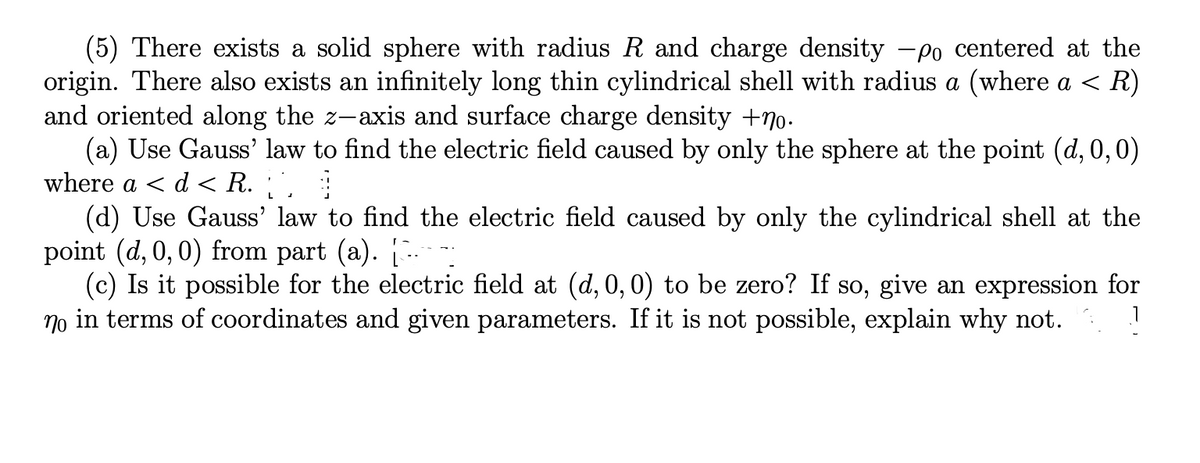(5) There exists a solid sphere with radius R and charge density -po centered at the origin. There also exists an infinitely long thin cylindrical shell with radius a (where a < R) and oriented along the z-axis and surface charge density +7o. (a) Use Gauss' law to find the electric field caused by only the sphere at the point (d, 0,0) where a < d < R. ¡ ', (d) Use Gauss' law to find the electric field caused by only the cylindrical shell at the point (d, 0, 0) from part (a). [..- (c) Is it possible for the electric field at (d,0,0) to be zero? If so, give an expression for no in terms of coordinates and given parameters. If it is not possible, explain why not.
(5) There exists a solid sphere with radius R and charge density -po centered at the origin. There also exists an infinitely long thin cylindrical shell with radius a (where a < R) and oriented along the z-axis and surface charge density +7o. (a) Use Gauss' law to find the electric field caused by only the sphere at the point (d, 0,0) where a < d < R. ¡ ', (d) Use Gauss' law to find the electric field caused by only the cylindrical shell at the point (d, 0, 0) from part (a). [..- (c) Is it possible for the electric field at (d,0,0) to be zero? If so, give an expression for no in terms of coordinates and given parameters. If it is not possible, explain why not.
Chapter6: Gauss's Law
Section: Chapter Questions
Problem 86AP: Two non-conducting spheres of radii R1 and R2 are uniformly charged with charge densities p1 and p2...
Related questions
Question

Transcribed Image Text:(5) There exists a solid sphere with radius R and charge density -po centered at the
origin. There also exists an infinitely long thin cylindrical shell with radius a (where a < R)
and oriented along the
(a) Use Gauss' law to find the electric field caused by only the sphere at the point (d, 0,0)
where a < d < R. ', :
(d) Use Gauss' law to find the electric field caused by only the cylindrical shell at the
point (d, 0, 0) from part (a). [.
(c) Is it possible for the electric field at (d, 0, 0) to be zero? If so, give an expression for
no in terms of coordinates and given parameters. If it is not possible, explain why not.
-axis and surface charge density +7o.
Expert Solution
This question has been solved!
Explore an expertly crafted, step-by-step solution for a thorough understanding of key concepts.
This is a popular solution!
Trending now
This is a popular solution!
Step by step
Solved in 3 steps with 2 images

Knowledge Booster
Learn more about
Need a deep-dive on the concept behind this application? Look no further. Learn more about this topic, physics and related others by exploring similar questions and additional content below.Recommended textbooks for you

